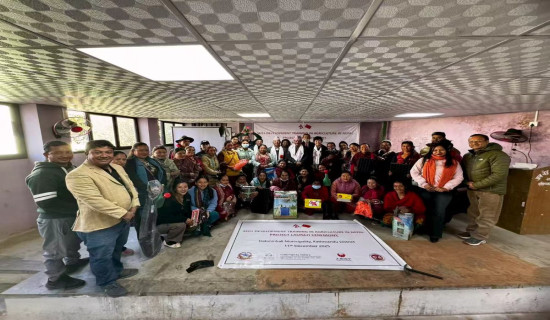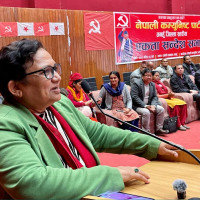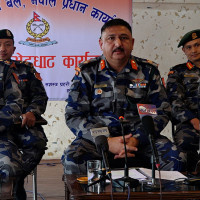- Saturday, 13 December 2025
Reading culture widens but publishing industry struggles against e-books
By Arpana Adhikari,Kathmandu, June 15: Sangita Acharya, 23, of Panauti-3 had never read a book beyond her school curriculum. But during the COVID-19 lockdown, out of boredom and anxiety, she picked up Palpasa Café, a Nepali novel brought by her sister. Since then, she got hooked to reading.
Acharya said the fear and isolation drove her to seek peace and deeper meaning. And the book drew her so deeply that reading became a lasting habit.
“Since then, I’ve read over 60 Nepali books, more digital and few printed copies,” shared Acharya, who works as a babysitter. “I read whenever I find a moment.”
Prabesh Ale, a Master’s student from Chitwan living in Kathmandu, who was browsing books at a New Road bookshop, shared how the pandemic turned him into an unexpected book lover.
“I was never fond of reading. But silence of lockdown pulled me toward the books. Now, books bring me joy and boredom never bothers,” he added.
While his friend spends weekends clubbing, Ale prefers staying in his hostel room, travelling to different cultures and places within the pages of books.
Anita Parajuli of Baneshwor, a mother and wildlife conservationist, shared how she nurtured her daughters’ reading habits by enrolling them in a library and regularly brining books home.
“To show them the value of reading, I had to start reading myself,” she said. “I’ve spent a lot on books, but since it’s not feasible to buy all, I borrow from the library. Now they bring the books themselves,” she shared happiness.
She added, “Reading broadens the mind and gives one wider perspective on the world.”
Parajuli shared how her colleagues motivate their kids to read by setting simple goals, asking them to read a certain number of books and write a short review. In return, they reward them with small gifts or items the children want.
On the crowded microbus en route to Thimi, Prasansha Shrestha, 27, a banker by profession, sat captivated in the book Many Lives, Many Masters, reading with quiet focus.
She shared how she has developed a habit of reading books whenever she gets a moment to herself, whether its during her lunch break, while commuting to the office or on her way back.
For Shrestha reading isn’t just a hobby, it’s a daily ritual that offers clarity, reflection and peace, even amid the chaos of the city life.
Like Acharya, Ale, Shrestha, Parajuli and her daughters, many young and middle-aged individuals have embraced the habit of reading, the shift that began after the COVID-19 pandemic.
Ram Paudel, owner of a bookstore in Jhoche who began selling books at New Road 32 years ago, confirmed that reading culture has significantly grown among Nepalis in recent years.
“Until a decade ago, most of my customers were 35 and older, often retired,” said Paudel. “But since COVID-19, youngsters and even schoolchildren as young as grade six, are my customers.”
He observed that teens prefer literary English books by foreign authors, as many find Nepali literature challenging.
“Boys usually go for suspense and thriller novels, while girls choose romantic fiction.
Meanwhile readers above 35 often prefer biography, poetry, academic or research-based books and those focused on spiritual awakenings.”
Challenges for the industry
Tulasi Prasad Agasti (Birendra), proprietor of Pragati Book Store in Putalisadak, however, said that while reading habits among youth have grown of late, it hasn’t benefited booksellers and authors significantly.
“Many young readers are leaving the country for work or study and the rise of e-books and pirated books (both of Nepali and foreign authors) has deeply affected booksellers, publishers and authors,” he said. He expressed his concern, “Free access to books in libraries is fine, but photocopying instead of buying harms the sale of printed books.”
Bhupendra Khadka, chairperson of Bookhill Publication, echoed similar concerns. “The book market has been weak for five years.” “Before a decade, the business was more vibrant. Now, aside from a few bestsellers, overall sales across literary genres remain unsatisfactory,” he noted.
He attributed the downturn to political instability, the 2015 earthquake, the Indian blockade, tax on imported books, the COVID-19 pandemic, economic hardship, increasing foreign migration and frustration among the people. “We have also tried digital formats too, but Nepali literature still hasn’t received the recognition it deserves,” he added.
The rise of digital reading
Younger readers are increasingly choosing e-books over printed one for affordability and convenience.
Prabesh Ale shared he prefer e-books, as they are easy to access and read anytime and anywhere. He informed that many of his friends have also shifted to digital books, as they are cost-effective, portable and have instant access.
“E-books have many interesting features too, like adjustable font size, built-in dictionary, easy highlight option, offer text-to-speech, and audio version or screen readers for people with disabilities,” he added. Aashish Mishra of Patan, who works at a UK-based company, said he switched to e-books six years ago and hasn’t bought a printed book since. “It’s easier and cheaper.”
Supporting this, Sagar Raj Subedi, Chief of TU Central Library, Kritipur said that library visits have declined as students now rely mainly on digital resources for academic, research and even literary reading. “Compared to the past, people now access books with just a click, making the digital formats more appealing,” he added.






-original-thumb.jpg)









